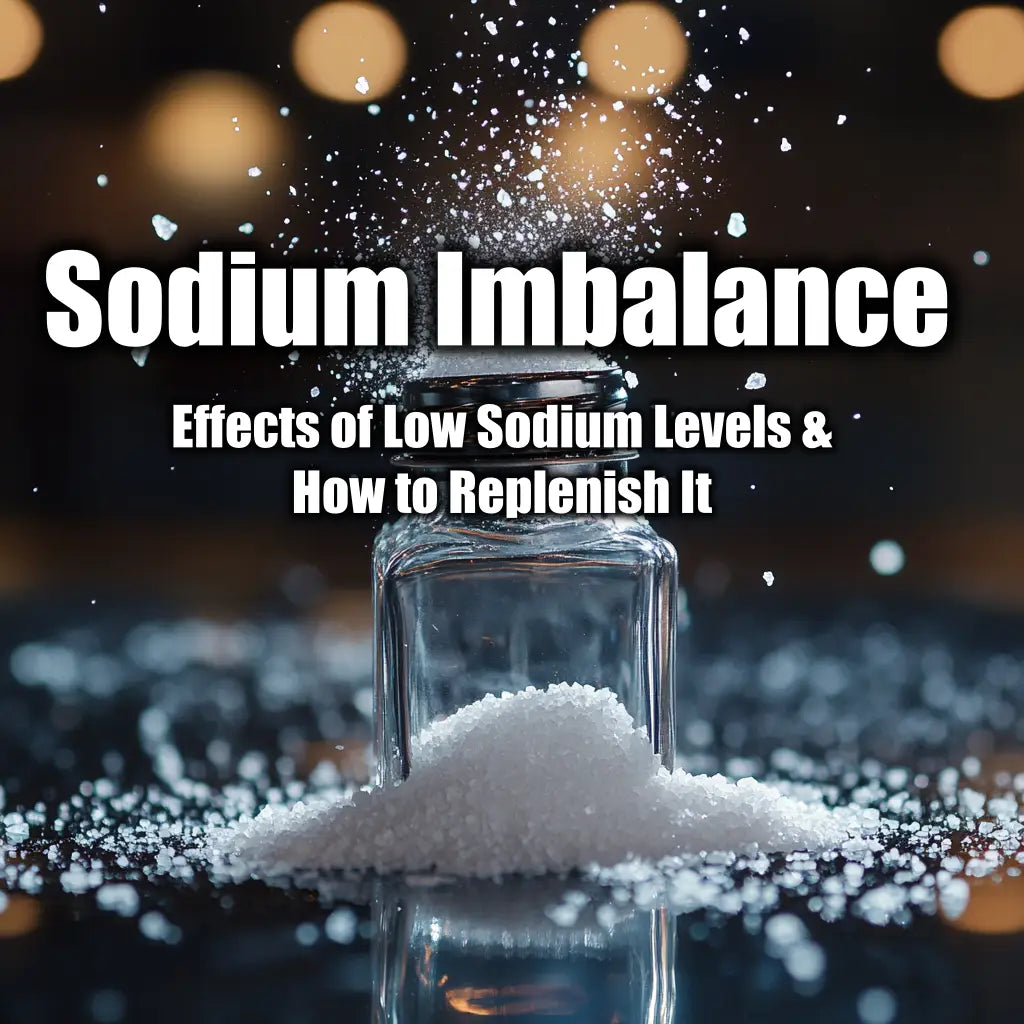Maintaining a balanced electrolyte level is crucial for overall health, particularly for sodium, which plays a vital role in regulating bodily functions. Electrolyte imbalance, especially a sodium imbalance, can lead to serious health issues.
This blog post will explore the symptoms of sodium imbalance, effective solutions to manage low sodium levels, and how Warrior Salt can help you achieve optimal hydration.
What Are Electrolytes and Their Importance?
Electrolytes are minerals that carry an electric charge, essential for various physiological functions. Sodium, potassium, magnesium, and calcium are key electrolytes that help regulate hydration, nerve function, and muscle contractions.
- Sodium: The most abundant electrolyte in the body, sodium helps regulate fluid balance and blood pressure.
- Potassium: Works in tandem with sodium to maintain proper muscle and nerve function.
- Calcium: Crucial for muscle contraction and nerve signaling.
- Magnesium: Plays a role in over 300 enzymatic reactions in the body.
Symptoms of Sodium Imbalance
Sodium imbalance can manifest through various symptoms, depending on whether the levels are too high or too low. Here are common signs to watch for:
Symptoms of Low Sodium and Potassium
- Fatigue: A lack of energy may signal an electrolyte imbalance.
- Headaches: Frequent headaches can be a result of low sodium levels.
- Muscle Cramps: Insufficient sodium may lead to muscle spasms.
- Nausea: Feelings of nausea can indicate an imbalance in electrolytes.
- Confusion: Severe sodium deficiency can affect cognitive functions.
Understanding these symptoms can help you take action before more serious complications arise.
Symptoms of Sodium Imbalance
- Thirst: An intense thirst can indicate dehydration and low sodium levels.
- Swelling: Swelling in the body can occur due to an imbalance of fluids.
- Irritability: Mood swings and irritability can be signs of sodium deficiency.
Understanding Sodium Imbalance
A sodium imbalance can be classified as either hypernatremia (high sodium levels) or hyponatremia (low sodium levels). Both conditions can have serious health implications.
- Hyponatremia: This condition occurs when sodium levels fall below normal. It can result from excessive fluid intake, certain medications, or chronic conditions. Symptoms may include headaches, nausea, and confusion.
- Hypernatremia: This condition arises when sodium levels are too high, often due to dehydration. Symptoms include thirst, confusion, and muscle twitching.
Managing Sodium Imbalance: Solutions
To prevent sodium imbalance and maintain optimal electrolyte levels, consider the following strategies:
- Stay Hydrated: Regular hydration helps maintain electrolyte levels. Aim for at least eight 8-ounce glasses of water daily.
- Balanced Diet: Include foods rich in sodium and other electrolytes, such as:
- Salted nuts
- Olives
- Pickles
- Dairy products
- Use Electrolyte Supplements: Warrior Salt electrolyte powder can provide essential electrolytes and help replenish lost sodium. This product is specifically designed to combat low sodium levels, ensuring you maintain your electrolyte balance effectively.
The Role of Warrior Salt in Replenishing Electrolytes
When your body loses sodium through sweat, illness, or excessive fluid intake, using a high-quality electrolyte powder like Warrior Salt can help. This powder not only replenishes sodium but also includes other essential electrolytes like potassium and magnesium, making it an ideal solution for hydration and recovery.
How Warrior Salt Works
Warrior Salt is designed to dissolve easily in water, allowing for quick absorption and effective hydration. Here’s how to use it:
- Mixing Instructions:
- Add one scoop of Warrior Salt to 16 ounces of water.
- Stir or shake until fully dissolved.
- When to Use:
- After intense physical activity
- During illness or dehydration
- As a daily supplement to maintain electrolyte balance
5 Ways to Combat Sodium Imbalance
Here are five effective ways to manage sodium imbalance:
1. Increase Water Intake
While it may seem counterintuitive, drinking enough water is crucial to help flush out excess sodium while replenishing your body's electrolyte levels. Proper hydration also aids in preventing dehydration and maintaining sodium balance.
2. Incorporate Electrolyte-Rich Foods
Include foods in your diet that are high in sodium and other electrolytes. Foods such as:
- Tomato juice: A great source of potassium and sodium.
- Sports drinks: These often contain electrolytes and can be helpful during workouts.
3. Add Warrior Salt to Your Routine
Using Warrior Salt can ensure that you are consistently replenishing electrolytes lost through sweat or physical activity. This powder provides a convenient and effective way to maintain hydration.
4. Monitor Your Sodium Intake
Be aware of how much sodium you are consuming in your diet. While some sodium is necessary, excessive amounts can lead to health issues. Aim to balance your intake by choosing natural, unprocessed foods when possible.
5. Regular Check-ups
If you frequently experience symptoms of sodium imbalance, consider regular medical check-ups to monitor your electrolyte levels. This is especially important for individuals with underlying health conditions.
Table: Sodium-Rich Foods for Replenishment
|
Food Item |
Sodium Content (mg) per Serving |
|
Canned Soup |
800-900 |
|
Pickles |
600-800 |
|
Salted Nuts |
200-300 |
|
Olives |
500-600 |
|
Tomato Juice |
500-700 |
Additional Resources
For more information on electrolytes and their benefits, check out these internal links:
- Benefits of Electrolyte Powder
- How Long Do Electrolytes Stay in Your Body?
- Electrolytes Normal Range
- Electrolyte Imbalance Headache
Conclusion
Sodium imbalance can have serious health implications, but by staying aware of the symptoms and incorporating solutions like Warrior Salt, you can effectively manage your electrolyte levels. Regular hydration, a balanced diet, and monitoring your sodium intake are crucial steps toward maintaining overall health.
By taking proactive measures to replenish your electrolytes, you can improve your well-being and reduce the risk of sodium imbalance-related complications.

